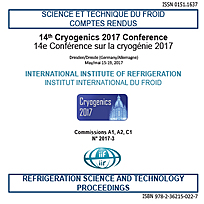
IIR document
Analysis of cascade cycle and reverse Brayton cycle based bog reliquefaction systems for their suitability in LNG carrier ships with dual fuel engines.
Number: pap. n. 0090
Author(s) : KOCHUNNI S. K., CHOWDHURY K.
Summary
Liquefied Natural Gas (LNG) carrier ships with dual fuel engines use natural gas often by pumping and vaporizing LNG. The cold energy of LNG can be utilized to improve the performance of the reliquefaction system. Cascade cycle (using hydrocarbon or derivatives) and Reverse Brayton cycle (RBC) (using nitrogen) are compared for their suitability as reliquefaction systems using exergy analysis. To condense an equal quantity of boil-off gas (BOG), heat exchangers and exergy input required for RBC are higher. RBC performs better when cold is utilized by BOG stream rather than by N2 stream. For cascade system, LNG cold cannot be extracted gainfully if flow rate of LNG through the pump is very low. One may apply the results given in this paper to choose either RBC or cascade cycles for reliquefaction of BOG utilizing cold from LNG fuel to engine and meet the criteria of size, power consumption and safety.
Available documents
Format PDF
Pages: 7 p.
Available
Public price
20 €
Member price*
Free
* Best rate depending on membership category (see the detailed benefits of individual and corporate memberships).
Details
- Original title: Analysis of cascade cycle and reverse Brayton cycle based bog reliquefaction systems for their suitability in LNG carrier ships with dual fuel engines.
- Record ID : 30021743
- Languages: English
- Source: Cryogenics 2017. Proceedings of the 14th IIR International Conference: Dresden, Germany, Mai 15-19, 2017.
- Publication date: 2017/05/15
- DOI: http://dx.doi.org/10.18462/iir.cryo.2017.0090
Links
See other articles from the proceedings (71)
See the conference proceedings
Indexing
- Themes: LNG and LPG
- Keywords: Fuel (vehicles); Comparison; Methane carrier; Liquefaction; Brayton; Simulation; Cascade system; LNG; Thermodynamic cycle
-
CO2 and H2H cryogenic removal process evaluatio...
- Author(s) : SPITONI M., XIONG X., ARTECONI A., et al.
- Date : 2017/05/15
- Languages : English
- Source: Cryogenics 2017. Proceedings of the 14th IIR International Conference: Dresden, Germany, Mai 15-19, 2017.
- Formats : PDF
View record
-
Utilization of engine exhaust gas in boil-off g...
- Author(s) : KOCHUNNI S. K., CHOWDHURY K.
- Date : 2019/05/08
- Languages : English
- Source: Cryogenics 2019. Proceedings of the 15th IIR International Conference: Prague, Czech Republic, April 8-11, 2019.
- Formats : PDF
View record
-
RELIABILITY, OPERABILITY AND EFFICIENCY OF LIQU...
- Author(s) : PERES R.
- Date : 1983/05/15
- Languages : English
View record
-
OFFSHORE PRODUCTION OF LNG FROM ASSOCIATED GAS.
- Author(s) : BORGAAS B., EIMER D.
- Date : 1989/10/17
- Languages : English
View record
-
REVIEW OF NATURAL GAS LIQUEFACTION CYCLES AND S...
- Author(s) : LINNETT D. T.
- Date : 1983
- Languages : English
View record
